Hathor › The Role of Women in the Roman World » Origins and History
Articles and Definitions › Contents
- Hathor › Who Was
- The Role of Women in the Roman World › Antique Origins
Ancient civilizations › Historical places, and their characters
Hathor › Who Was
Definition and Origins
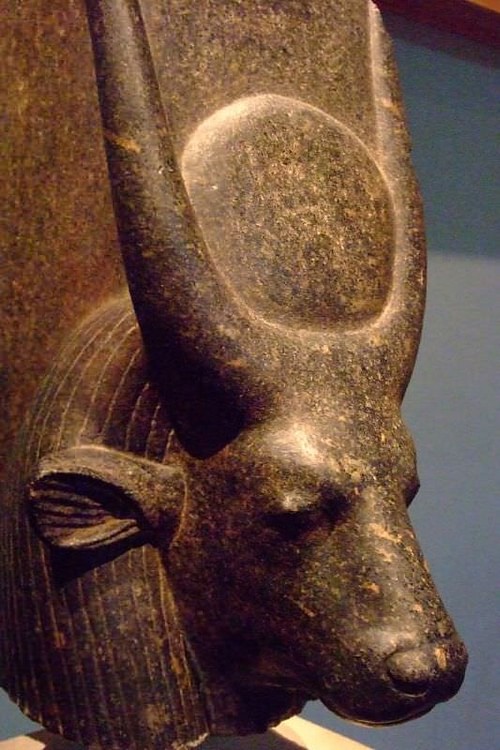
Hathor is an ancient Egyptian goddess associated, later, with Isis and, earlier, with Sekhmet but eventually was considered the primeval goddess from whom all others were derived. She is usually depicted as a woman with the head of a cow, ears of a cow, or simply in cow form. In her form as Hesat she is shown as a pure white cow carrying a tray of food on her head as her udders flow with milk. She is closely associated with the primeval divine cow Mehet-Weret, a sky goddess whose name means "Great Flood" and who was thought to bring the inundation of the Nile River which fertilized the land.
Through this association, Hathor came to be regarded as the mother of the sun god Ra and held a prominent place in his barge as it sailed across the night sky, into the underworld, and rose again at dawn. Her name means "Domain of Horus " or " Temple of Horus" which alludes to two concepts. The first allusion is to the part of the sky where the king (or dead king) could be rejuvenated and continue rule (or live again) while the second is to the myth that Horus, as sun god, entered her mouth each night to rest and returned with the dawn. In both cases, her name has to do with re-birth, rejuvenation, inspiration, and light. Her relationship with the sky identified her with Venus, the evening and morning star.
The sistrum is her instrument which she used to drive evil from the land and inspire goodness. She is the patron goddess of joy, celebration, and love and was associated with Aphrodite by the Greeks and with Venus by the Romans. She was always, from the earliest times, associated with women and women's health in body and in mind. In time, women came to identify with Hathor in the afterlife the same way that, previously, all people identified with the god Osiris. She was an immensely popular and influential goddess. Scholar Geraldine Pinch comments on this, writing :
Hathor was the golden goddess who helped women to give birth, the dead to be reborn, and the cosmos to be renewed. This complex deity could function as the mother, consort, and daughter of the creator god. Many lesser goddesses came to be regarded as "names" of Hathor in her contrasting benevolent and destructive aspects.She was most commonly shown as a beautiful woman wearing a red solar disk between a pair of cow's horns (137).
The red solar disk, as well as a number of Hathor's personal attributes, would come to be associated with the later goddess Isis. In time, Isis absorbed more and more of the characteristics of Hathor until she supplanted her as the most popular and widely worshipped in Egypt.
MYTHICAL ORIGINS
Although in time she came to be considered the ultimate personification of kindness and love, she was initially literally a blood-thirsty deity unleashed on mankind to punish humans for their sins. An ancient tale similar to that of the biblical flood tells of the great god Ra becoming enraged at human ingratitude and evil and releasing Sekhmet upon humanity to destroy them.Sekhmet descends on the world in a fury of destruction, killing everyone she finds and toppling their cities, crushing their homes and tearing up fields and gardens. At first, Ra is pleased because humanity had forgotten him and the gifts of the gods and had turned to only thinking of themselves and following after their own pleasure. He watches Sekhmet's swath of destruction with satisfaction until the other gods intervene and ask him to show mercy. They point out that Sekhmet is going too far in teaching this "lesson" to humanity and how, soon, there will be no human beings left on earth to benefit from it.
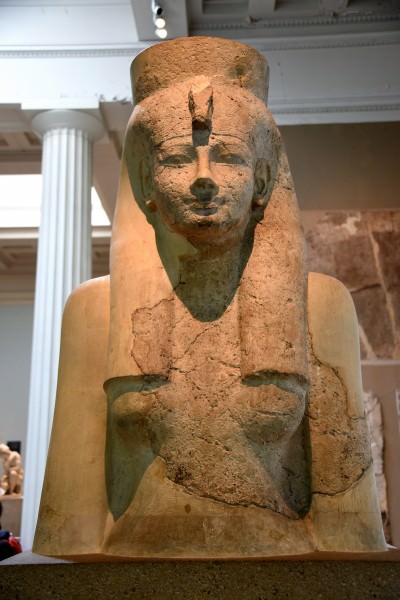
The Goddess Hathor
Ra regrets his decision and devises a plan to stop Sekhmet's blood lust. He orders Tenenet, the Egyptian goddess of beer, to brew a particularly strong batch and then has the beer dyed red and delivered to Dendera. Sekhmet, by this time, is crazed with the thirst for more blood and, when she comes upon the blood-red beer, she quickly seizes it and begins drinking.
She becomes drunk, falls asleep, and wakes up as Hathor the benevolent. Humanity was spared destruction and their former tormentor became their greatest benefactress. Following her transformation, Hathor bestowed only beautiful and uplifting gifts on the children of the earth and assumed such high status that all the later goddesses of Egypt can be considered forms of Hathor. She was the primordial Mother Goddess, ruler of the sky, the sun, the moon, agriculture, fertility, the east, the west, moisture and childbirth. Further, she was associated with joy, music, love, motherhood, dance, drunkeness and, above all, gratitude.
WORSHIP OF HATHOR
HATHOR'S CULT CENTER WAS AT DENDERA, EGYPT, BUT SHE WAS WIDELY REGARDED AND WORSHIPPED THROUGHOUT EGYPT.
Unlike other deities of ancient Egypt, whose clergy needed to be of the same sex as the deity they served, those who served Hathor could be men or women. Hathor's cult center was at Dendera, Egypt, but she was widely regarded and worshipped throughout Egypt to the extent that she was also honored as a goddess of the afterlife in the Field of Reeds (the Egyptian land of the dead). Originally, when one died in ancient Egypt, whether male or female, one assumed the likeness of Osiris (lord and judge of the dead) and was blessed by his qualities of moral integrity. So popular was Hathor, however, that, in time, the female dead who were deemed worthy to cross into the Field of Reeds assumed Hathor's likeness and qualities while the male dead continued to be associated with Osiris. Geraldine Pinch writes:
The Coffin Texts and the Book of the Dead have spells to help the deceased live forever as a follower of Hathor.In a Late Period story, Hathor rules the underworld, emerging to punish those who behave unjustly on earth. By the Greco- Roman period, dead women in the afterlife identified themselves with Hathor instead of Osiris. It was only after Isis took over many of her attributes that Hathor lost her place as the most important of Egyptian goddesses (139).
Hathor's popularity is attested to by the number of minor goddesses who shared her attributes and were considered aspects of the Mother Goddess. The most important of these were the Seven Hathors who were present at the birth of a human being and decreed their fate. Hathor was, in early times, worshipped in the form of a cow or as a cow with stars above her. Later she was pictured as a woman with the head of a cow and, later still, as a woman complete with a human face but sometimes with the ears or horns of a cow. The Seven Hathors shared these attributes but also had a red ribbon which they used to bind evil forces and dark demons. The Seven Hathors were venerated highly in life for their ability to assist in matters of love and protection from harm and, after death, for their protective abilities against the forces of darkness.
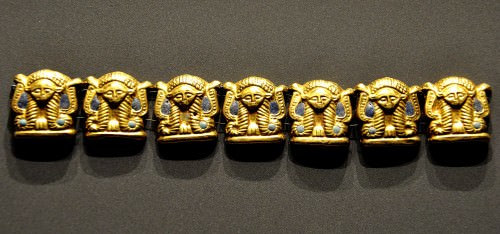
Chain with Hathor Heads
As a goddess who transcended life and death, Hathor was widely worshipped and came to be idenified with a deity inscriptions call The Distant Goddess. This is a goddess who abandons her father Ra and assumes the form of a wild feline to elude any attempts to find her or catch her. She vanishes into the distant desert and hides in the arid plains. This goddess was identified with Mehit, a protective goddess, with Sekhmet, Bastet, Mut, and others but quite often with Hathor. A god is sent forth by Ra to find his daughter and bring her home and, when this happens, she brings with her the inundation of the Nile River which overflowed its banks and brought life to the people. Before she released the life-giving waters, however, she had to be placated and shown appreciation. Geraldine Pinch writes:
When the Distant Goddess returned, she brought the inundation with her, but she had to be pacified with music, dancing, feasting, and drunkenness. This was the mythical justification for the wild, ecstatic elements in Hathor's cult. It was proper for the whole of creation to rejoice when Hathor appeared again in all her radiant beauty and joined forces with her father (138).
Pinch notes that this union of Hathor and her creator-father "could be thought of in sexual terms or, more abstractly, as a merging of the creator with his own active power" (138). An example of this is the role Hathor plays in one of the versions of the story of The Contendings of Horus and Set which continues the tale of the Osiris Myth.
HATHOR AND THE OSIRIS MYTH
After Set murdered Osiris and then hacked him into pieces, he scattered the body parts all across the land and flung some into the Nile. Isis gathered all the parts of her husband back together with the help of her sister Nephthys and brought Osiris back to life but he was incomplete because a fish had eaten his penis and it could not be restored. Isis then transformed herself into a kite (a falcon) and flew around Osiris' body, drawing his seed into her and becoming pregnant with Horus. Osiris then descended into the underworld to become Lord of the Dead while Isis was left alone to raise her son and Set usurped Osiris' place as king of the land.
Isis hid Horus from Set until the boy was grown; at which point Horus challenged Set for rule of the land. This struggle is sometimes represented as a battle but, in the story known as The Contendings of Horus and Set, it is a trial overseen by the Ennead, a tribunal of nine powerful gods, who are to decide who is rightful king. Chief among these gods is Hathor's father Ra who, at one point becomes so upset with the proceedings, he refuses to participate. Geraldine Pinch relates the rest of the story:
Ra becomes angry when he is insulted by the baboon god Babi and lies down on his back. This implies that the creator sun god was sinking back into the inert state that would mean the end of the world. Hathor, Lady of the Southern Sycamore, visits her father and shows him her genitals. He immediately laughs, gets up, and goes back to administering justice. Hathor has aroused the sun god and driven away his evil mood (138).
Although clearly a sexual gesture, the abstract interpretation is of the importance of balance between the feminine and the masculine principles in maintaining order and harmony. Hathor reveals herself to her father in an unexpected gesture which lightens his mood and puts things in perspective. The balance between the duality of feminine and the masculine, between light and dark, fertility and aridity is emphasized throughout Egyptian culture in the gods and the myths relating to them.
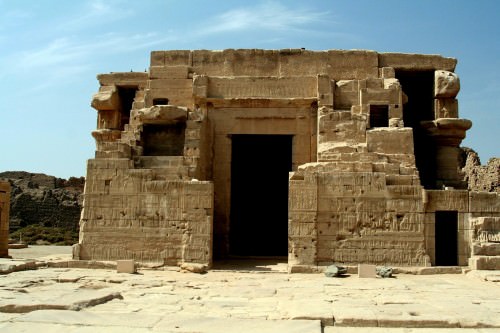
The Temple of Hathor
HATHOR AND THE EYE OF RA
This balance is seen in the concept of the Eye of Ra, the female conterpart to the male aspect of creation embodied in Ra. The Eye of Ra, like the Distant Goddess, was associated with a number of female deities but, again, often Hathor. Geraldine Pinch notes that "the ancient Egyptian word for eye ( irt ) sounded like a word for "doing" or "acting". This may be why the eyes of a deity are associated with divine power at its most interventional. Since the word irt was feminine in gender, divine eyes were personified as goddesses" (128). The Distant Goddess story is actually an Eye of Ra story in that the feminine aspect of the divine goes forth, acts upon its environment, and returns to bring transformation.
This same pattern is seen in the creation tale featuring Atum (Ra) and the ben-ben when he sends his children out with his eye to create the world. Hathor was often referred to as "The Eye of Ra" or "The Eye of Atum" and her sun disk is often represented as an eye from which the sun is born. In the story of the sun god's voyage through the night sky and the underworld, Hathor stands in the prow keeping watch for any sign of danger from Apophis. Throughout Egyptian history she was known as the daughter of Nut and Ra, Wife of Ra, mother of gods, and great Mother Goddess (perhaps related to the even older goddess Neith ) so it is no surprise that popular stories such as the Distant Goddess or concepts like the Eye of Ra would tend to feature her.
Some ancient stories depict her as the mother of Horus the Elder and others as the wife of Horus of Edfu, resulting in the birth of Horus the Younger who was later regarded as the son of Osiris and Isis. Hathor's early identification as the mother of Horus, the god most closely associated with the ruler of Egypt, attests clearly to her importance prior to the rise in popularity of the Myth of Osiris when Isis became Horus' mother. Hathor was worshipped in every region of Egypt before the ascent of Isis and her cult was popular with both the poor working class of Egypt and the ruling elite.
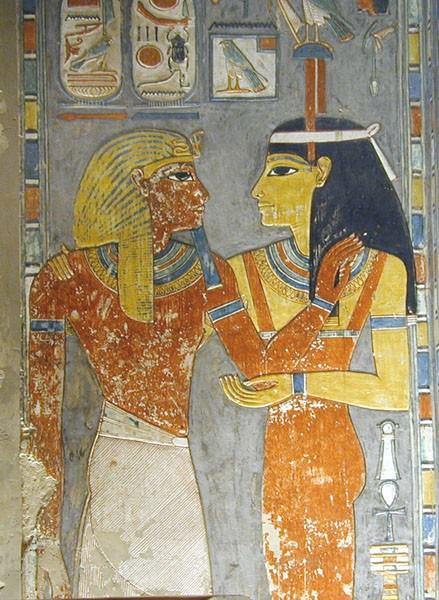
The Tomb of Horemheb
THE FIVE GIFTS OF HATHOR
A part of the initiation into her cult appears to have been a ritual known as The Five Gifts of Hathor in which a communicant would be asked to name the five things they were most grateful for while looking at the fingers of their left hand. As the poor of Egypt did not own their own land, but labored for others in the fields, their left hand was always visible to them as they reached out to harvest grain which would then be cut by the blade in their right hand. By naming the five things one was grateful for, and identifying them with the fingers of the left hand, one was constantly reminded of the good things in one's life and this kept one from the `gateway sin' of ingratitude from which, it was thought, all other sins followed. For the more affluent of Egypt, considering the Five Gifts would have been a way to keep from envying those more prosperous than oneself and a means by which one was reminded to be humble in the face of the gods. This humility would show itself by one's service to others.Historian Margaret Bunson comments on this:
In the Daily Royal Rites, as shown on temple reliefs, Hathor nursed the king or his priestly representative from her breasts, thus giving him the grace of office and the supernatural powers to protect Egypt (107).
She served the king and his court as nurse and, by doing so, fed all the people of Egypt as the prosperity of the land was intimately tied to the health, well-being, and stability of the king. If a goddess of Hathor's stature could freely serve others, it was thought, so could anyone else. Hathor continued this service to humanity after death as Geraldine Pinch notes:
As the goddess of the West, Hathor welcomes the setting sun into her outstretched arms. For both gods and peole, Hathor eased the transition from death to new life. The time and manner of a person's death was decreed by a sevenfold form of Hathor. As Lady of the Necropolis, she opened the gates of the underworld. As a tree goddess, she revived the newly dead with shade, air, water, and food. The spirits of the dead could imbibe eternal life from the milk of the seven Hathor cows (138-139).
Hathor's humble service is depicted through inscriptions and texts throughout Egypt's history from the Early Dynastic Period (c. 3150-2613 BCE) through the last dynasty to rule Egypt, the Ptolemaic Dynasty (323-30 BCE). In her earthly form as a dairy cow, Hathor was known as Hesat, the wet-nurse to the gods, and is always associated with motherhood, motherly instincts, and the care of others. Milk was known as `The beer of Hesat' and The Milky Way as seen in the night sky also came to be associated with her as it was considered a heavenly Nile River, the giver and sustainer of all life. As mistress of song and dance, of celebration and gratitude, bringer of life and comforter in death, Hathor embodied the heavenly Nile in all ways as she brought the best gifts of the gods to the people of earth.
The Role of Women in the Roman World › Antique Origins
Ancient Civilizations
The exact role and status of women in the Roman world, and indeed in most ancient societies, has often been obscured by the biases of both ancient male writers and 19-20th century CE male scholars, a situation only relatively recently redressed by modern scholarship which has sought to more objectively assess women's status, rights, duties, representation in the arts, and daily lives; and all this from almost exclusively male source material dealing with a male-dominated Roman world.
WOMEN IN MYTHOLOGY
Unlike some other ancient cultures such as the Greeks who had formed a creation myth where woman was a creature secondary to man and, more specifically, in the form of Pandora, a bringer of unhappiness and vices, the Romans had a more neutral approach where humanity, and not specifically the male, was created by the gods from earth and water. Ovid 's Metamorphoses, for example, does not specify whether the first human was a man or a woman. At least in a physical sense then men and women were not regarded as belonging to a different species as in the Greek world, a view often reiterated in Roman medical treatises.
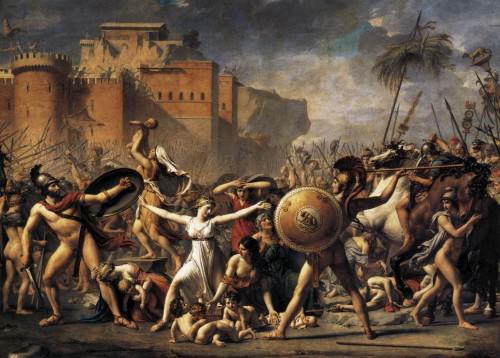
The Intervention of the Sabine Women
One of the most famous early episodes in Roman mythology that reveals much about attitudes to women is the Rape of the Sabine women. In the story, the first settlers of Rome abducted women from neighbouring tribes, taking them as their wives.One of the reasons for this action may have been a desire to form local alliances through blood ties. Naturally, these tribes sought to reclaim their women and so declared a state of war. However, the abducted women - led by Hersilia, the wife of Romulus - actually tried to intervene at this stage to prevent bloodshed. The story echoes the important role women played in linking families in Roman society - their family of birth and then of marriage.
WOMEN & THE FAMILY
In many cases Roman women were closely identified with their perceived role in society - the duty of looking after the home and to nurture a family ( pietas familiae ), in particular, to bear legitimate children, a consequence of which was an early marriage, (sometimes even before puberty but typically around 20 years old), in order to ensure the woman had no sexual history which might embarrass the future husband. The Roman family was male-dominated, typically headed by the most senior male figure ( paterfamilias ). Women were subordinate and this is reflected in Roman naming practice. Male citizens had three names: praenomen, nomen, and cognomen, whilst all women in the same family were referred to using the feminine version of the family name. A married woman could keep her maiden name or be referred to using her husband's name (eg Cicero 's Terentia). Within the family women would attend to the home and its slave workforce, work on handicrafts, and upper class females might also study academic subjects such as literature and philosophy.
THIS CLOSE DEPENDENCE OF WOMEN ON THEIR MALE RELATIVES WAS REFLECTED IN SUCH MATTERS AS LAW & FINANCE WHERE WOMEN WERE LEGALLY OBLIGED TO HAVE A NOMINATED MALE FAMILY MEMBER ACT IN THEIR INTERESTS.
This close dependence of women on their male relatives was also reflected in such matters as law and finance where women were legally obliged to have a nominated male family member act in their interests ( Tutela mulierum perpetua ). The only exceptions to this arrangement were women with three children (from c. 17 BCE), freedwomen with four children, and Vestal Virgins. This rule was designed to keep property, especially inherited property, in the male-controlled family, even if male and female offspring had equal inheritance rights under Roman law. However, in actual practice families may not always have followed the letter of the law in this area, just as with many other matters, and there is evidence of women running their own financial affairs, owning businesses, running estates etc., especially in cases where the principal male of the family had died on military campaign.
Another, even more chauvinistic explanation of this rule which allowed women to inherit and own but not control property was that they were thought incapable of managing such affairs for themselves. This view that women had weak judgement ( infirmitas consilii ) was expounded by Cicero, for example. Roman law did, though, at least stipulate that a wife's property be kept separate from her husband's (excepting the dowry) and it could be reclaimed following a divorce. Separation by divorce was easily achieved by both parties under Roman law but any children of the couple legally belonged to the father or nearest male relative if he was no longer living. In the later empire, and especially following legislation imposed by Constantine, divorce became much more difficult, especially for the female party.
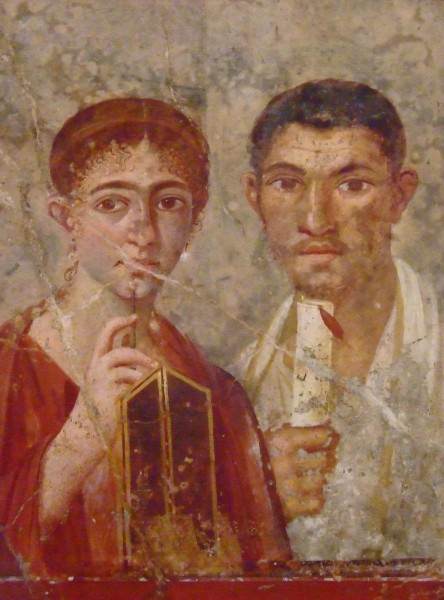
Fresco, Pompeii
WOMEN IN WIDER SOCIETY
Roman women had a very limited role in public life. They could not attend, speak in, or vote at political assemblies and they could not hold any position of political responsibility. Whilst it is true that some women with powerful partners might influence public affairs through their husbands, these were the exceptions. It is also interesting to note that those females who have political power in Roman literature are very often represented as motivated by such negative emotions as spite and jealousy, and, further, their actions are usually used to show their male relations in a bad light. Lower class Roman women did have a public life because they had to work for a living. Typical jobs undertaken by such women were in agriculture, markets, crafts, as midwives and as wet-nurses.
Roman religion was male-dominated but there were notable exceptions where women took a more public role such as the priestesses of Isis (in the Imperial period) and the Vestals. These latter women, the Vestal Virgins, served for 30 years in the cult of Vesta and they participated in many religious ceremonies, even performing sacrificial rites, a role typically reserved for male priests. There were also several female festivals such as the Bona Dea and some city cults, for example, of Ceres.Women also had a role to play in Judaism and Christianity but, once again, it would be men who debated what that role might entail.
THE OTHER WOMEN
Roman women could be separated (not always absolutely clearly) between those who were considered respectable and those who were not. Many Roman males had the somewhat hypocritical stance that their female relations should be honourable and chaste guardians of morality while at the same time they were more than willing to avail themselves of the services of lovers and prostitutes.
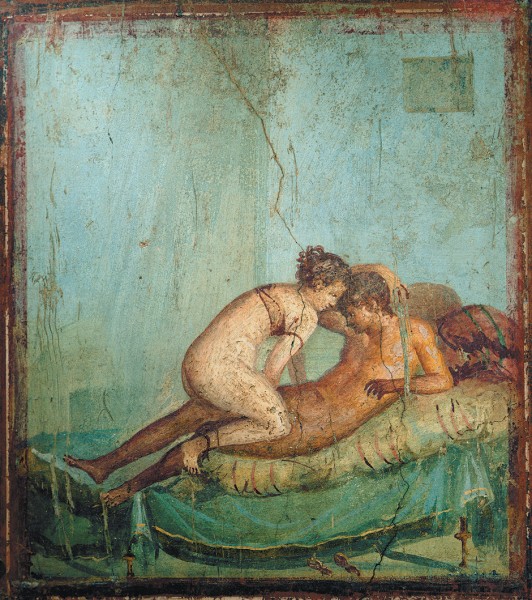
Sex in Pompeii
To remind everyone of who was who clothes became a useful tool. Respectable women wore a long dress or stola, a mantle ( palla ) and had ties in their hair ( vittae ) whilst prostitutes wore a toga. If a respectable woman was found guilty of adultery, one of the punishments was to wear the toga. It is interesting that women were considered to belong either in one group or the other (there was no third category) but at the same time it was felt necessary to identify them with visual signs lest an embarrassing confusion occurred. The distinction between these two groups was not just a moral one for prostitutes and other lower class women had even fewer rights than women of a higher social status. Prostitutes and waitresses, for example, could not prosecute for rape and the rape of slaves was considered merely as property damage sustained by the owner.
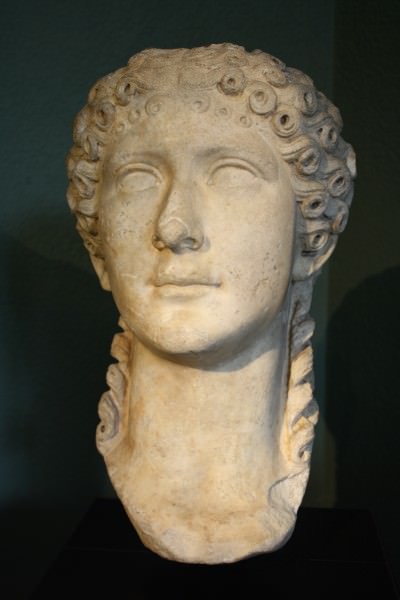
Agrippina The Younger
FAMOUS ROMAN WOMEN
CONCLUSION
Roman law and social norms were, then, heavily weighted in favour of males but the full practical application of these laws and attitudes in specific cases is often difficult to determine, especially as almost all source material is from a male perspective, and an elite one at that. That women were regarded as inferior in legal terms seems clear but there are also countless texts, inscriptions, and even idealised portrait sculpture which point to the Roman male's appreciation, admiration and even awe of women and their role in everyday life. Roman males did not think women their equal but neither did they hate them. Perhaps the ambivalent attitude of Roman men to their women is best summarised by the words of Metellus Numidicus who was quoted in a speech by Augustus when the emperor addressed the assembly, 'nature has made it so that we can not live with them particularly comfortably, but we can't live without them at all'.
LICENSE:
Article based on information obtained from these sources:with permission from the Website Ancient History Encyclopedia
Content is available under License Creative Commons: Attribution-NonCommercial-ShareAlike 3.0 Unported. CC-BY-NC-SA License